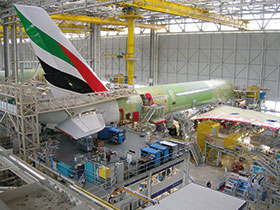

Today’s aerospace factory floor is nothing like the hectic, noisy production facility of the past. The latest techniques, designs and equipment make modern manufacturing efficient, organised and structured. But what about tomorrow? The future of the aircraft factory is a research and technology project aimed to push emerging technologies to improve the competitiveness of Airbus manufacturing processes where manual operations are still predominant today.
The challenge
Manufacturing and assembly of aircraft, which involve tens of thousands of steps that must be followed by operators, and a single mistake in the process could cost hundreds of thousands of dollars to fix, making the room for error very small.
The solution
Adding intelligence to the tools and shopfloor systems will help to simplify the production process and provide improved efficiency by managing and checking the tasks the operator is completing. Using the National Instruments (NI) System on Module, quick prototyping of these smart tools is enabled using NI’s approach to system design.
Results
Cyber-physical systems and Big Analog Data enable a smarter, operator-centric production that allows operators and machines to collaborate in the same physical environment. The Factory of the future also implies the extensive use of a modular platform with a high level of abstraction based on commercial off-the-shelf modules. One of the key components for improving efficiency in such the factories is smarter tools. These smart devices are designed to communicate with a main infrastructure or locally with operators or other tools, but only when it is required to provide situational awareness and make real-time decisions based on local and distributed intelligence in the network.
In the case of a manufacturing facility, smart tools can help simplify the production process and improve efficiency by removing physical data logs and manuals. Operators must focus on their operational tasks, during which they need to keep their hands free for using the appropriate tools. Most of the previous initiatives linked to ‘paperless projects’ were focused on ‘paper suppression,’ or replacing paper with tablets, but they still consumed ‘passive/dead data.’ Smart tools enable another alternative, ‘data in context’, which is generated and consumed continuously – in other words, ‘live data’.
Developing an aeroplane involves tens of thousands of steps that operators must follow with many checks in place to ensure quality. By adding intelligence to the system, the smart tools understand the actions that the operator must perform next and automatically adjust the tools to the proper settings, which simplifies the task for the operator. Once the action is completed, the smart tools can also monitor and log the results of the action, which improves the efficiency of the production process.
As an example, a given subassembly of an aeroplane has roughly 400 000 points that need to be tightened down, which requires over 1100 basic tightening tools in the current production process. The operator has to follow a list of steps and ensure the proper torque settings for each location using the correct tool. Because of the manual process, human error adds a lot of risk to the production. This is significant since even a single location being tightened down incorrectly could cost hundreds of thousands of dollars in the end. A smart tightening tool understands which task the operator is about to perform using vision to process its surroundings and automatically set the torque. In addition, the device can record the outcome of the task in a central database to ensure the location was set properly. With the central manufacturing execution system (MES) database and the distributed intelligence of the devices, production managers can precisely pinpoint the procedures and processes that need to be reviewed during quality control and certification.
“We evaluated several systems on modules (SOMs) and embedded single-board computers (SBCs) and there is no comparison to the software integration offered by National Instruments,” said Airbus’ Sébastien Boria. “We estimate that our time to deliver with the NI SOM is a tenth of the time using alternative approaches because of the productivity gains of NI’s approach to system design, particularly with NI Linux Real-Time and the LabVIEW FPGA module.”

© Technews Publishing (Pty) Ltd | All Rights Reserved